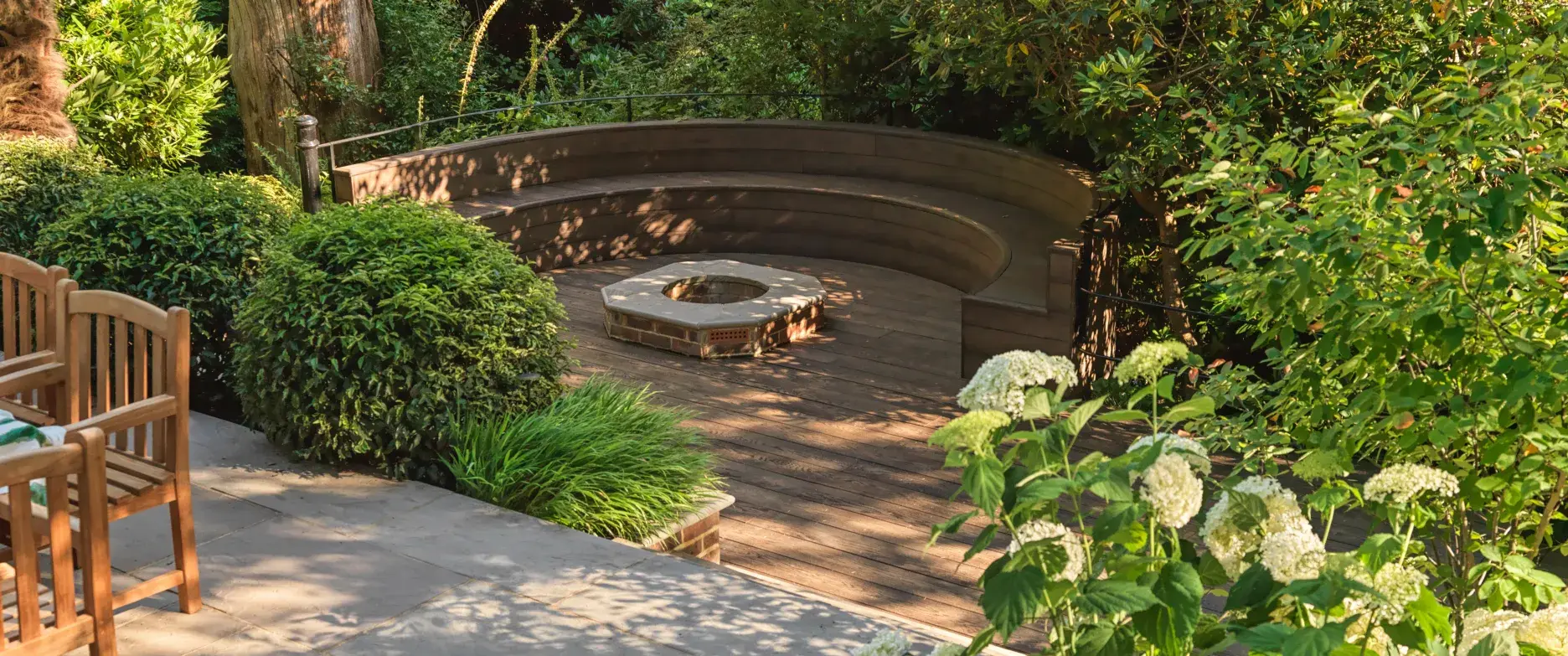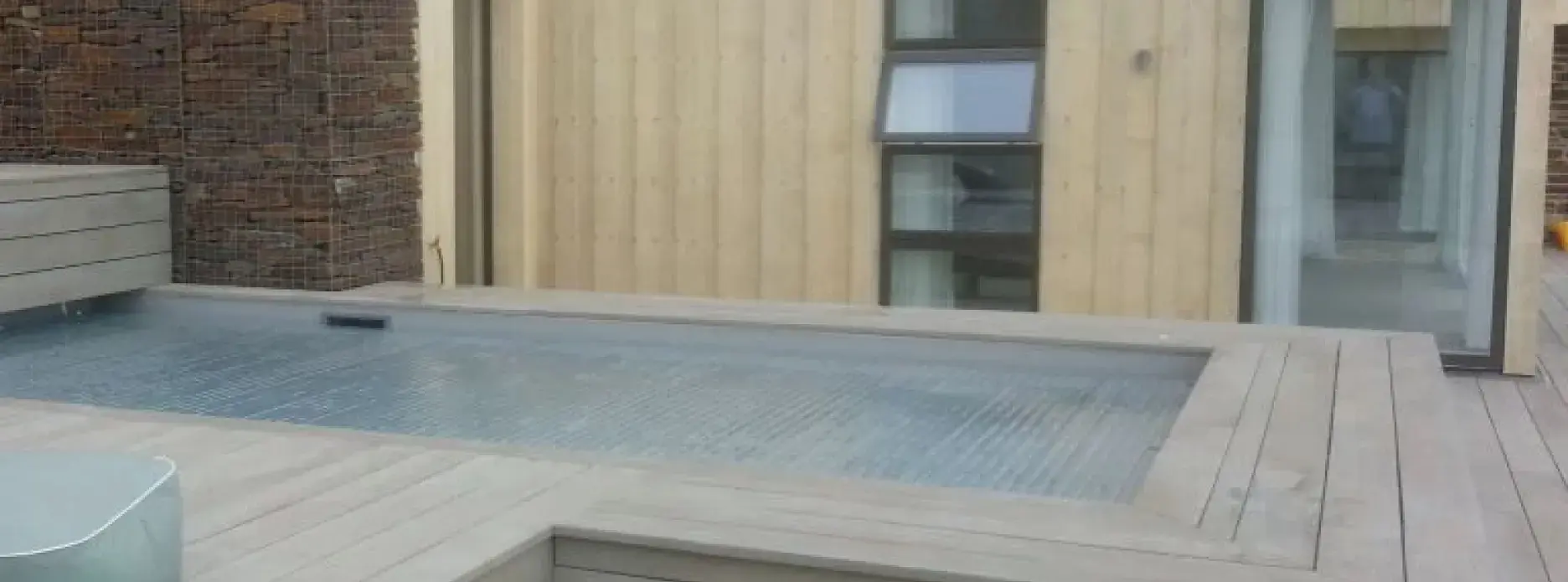MIllboard knowledgebase
Millboard Composite Decking vs. Traditional Composite Decking

Article Highlights
When it comes to outdoor decking, composite materials have become the go-to solution for homeowners and designers seeking the perfect blend of durability, style, and minimal maintenance. Composite decking is a modern alternative to wood that offers the appearance of natural wood with far less hassle.
Let's look at how Millboard composite decking compares to traditional composite decking options. We’ll delve into essential factors like raw materials, aesthetics, durability, safety features, and installation to help you determine the right choice for your outdoor space.
Introducing Composite Decking
Composite decking has grown in popularity as a durable and low maintenance alternative to traditional timber decking. Traditionally, composite decking is made from a mixture of wood fibres and plastic, offering a balance between visual appeal and performance. However, the decking market has evolved; advanced composite materials such as Millboard are redefining the types of decking options available.

Unlike traditional wood decking, which requires regular cleaning and wood treatment to protect against rotting and fading from UV exposure, Millboard composite decking is designed for long-term durability with low maintenance requirements. The unique resin mineral board used in Millboard products ensures superior performance against rot and moisture damage.

What Sets Millboard Apart in Composite Decking
Millboard takes composite decking materials to the next level with its hand-moulded design. Unlike traditional composite decking, which often relies on uniform patterns and synthetic looks, Millboard decking is moulded from real timber, capturing the intricate details and variations of natural wood grain. Each board is hand-finished, ensuring a premium look and eliminating the need for expensive decking treatments.
Key Differences:
- Unique Lastane® Surface: The top layer of Millboard decking is made from a unique resin, known as Lastane®, providing a soft-touch surface that remains durable against scratches, stains, and fading from UV exposure.
- Fibre-Reinforced Core: Beneath the Lastane® surface, a polyurethane resin core reinforced with fibreglass offers robust structural strength, eliminating concerns of rot, warping and deterioration common in other wood fibre composites.
- Minimal Maintenance: Unlike traditional timber decking, Millboard composite decking does not require staining, sealing, or regular cleaning beyond simple washing with soapy water.
Material Composition and Durability

Traditional Composite Decking
Most traditional composite decking boards are made from a mix of wood fibres and recycled plastics. Modern composite decking materials have a more durable surface capping layer which not only enhances the look of wood but also protects the core from damage. Wood, plastic composites do usually offer better durability compared to natural wood, it can still be susceptible to issues like moisture absorption, which can lead to warping or mould over time. One way to ensure your decking stands the test of time is to choose wood-free decking options such as Millboard.
Millboard Composite Decking
Millboard decking uses a high-performance resin mineral board that does not absorb moisture. This makes it ideal for areas exposed to the elements, such as poolside decking, docks, or regions with high rainfall. The fibreglass reinforcement adds to its strength, making it suitable for high-traffic areas without the risk of cracking or splitting. Additionally, Millboard’s surface is designed to last decades, evident in the residential warranty for peace of mind.

Design and Aesthetic Appeal
One of the key reasons homeowners and designers choose composite decking is its aesthetic appeal. Millboard composite decking offers the most authentic wood look available. Each board is hand-moulded from real oak, capturing the organic grain patterns and subtle texture variations of the original timber mould. These nuances are hard replicate in other types of composite decking.
Millboard’s Range Includes:
- Enhanced Grain: Offers a smooth finish that replicates the clean lines of freshly sawn timber.
- Weathered Oak: Moulded from 100-year-old oak boards, providing a rustic, aged appearance that enhances any outdoor space.
- Lasta-Grip®: Combines slip resistance with beautiful design for added safety in areas like steps or pool surrounds.
- Modello: Provides the elegant appeal of enhanced grain with up to 50 pattern combinations to make your outdoor space truly one-of-a-kind.
With a broad spectrum of colours, finishes, patterns and configurations available, Millboard composite decking can complement various architectural styles, ensuring it's the right choice for your garden, holiday home or commercial area.
Safety Features and Slip Resistance
Safety is a critical consideration for any decking project, especially in outdoor environments prone to rain and moisture. Traditional composite decking can become slippery when wet, depending on the finish and design. Although surface treatments can improve grip, these often wear down over time.
Millboard’s unique resin mineral board surface, however, has high slip resistance. Its pliable top layer provides excellent traction even in wet conditions, making it ideal for use around pools, outdoor kitchens, or any areas where safety is a top concern.

Installation and Maintenance
Ease of Installation
Millboard decking’s unique construction makes it easy to work with using standard carpentry tools, whether you’re a professional installer or a DIY enthusiast. The boards are designed to be cut and configured to fit your space. Moreover, Millboard’s Durafix® screws allow for hidden fixings and a clean, uncluttered surface.
Low Maintenance Requirements
Millboard’s non-porous surface means it requires little maintenance—just occasional cleaning with soap, water and a soft bristle brush. Traditional wood decking and some composite decking options require regular staining and sealing, making Millboard the preferred choice for those who want to spend less time on upkeep and more time enjoying their beautiful outdoor space.
Environmental Considerations
Millboard decking doesn't use any wood content which helps your decking last longer than the alternatives. Moreover, the brand is committed to sustainability. The boards use 38% recycled materials, and production operates using renewable energy sources. Recycling as much waste from production as possible, is a top priority.
Choosing the Right Decking for Your Needs
Selecting the right decking material depends on your specific needs—whether that’s the look of wood, stain resistance, or ease of maintenance. Millboard composite decking offers distinct advantages over traditional Wood Plastic Composites, making it a popular composite decking brand for style-savvy homeowners.
If you’re looking for decking that combines the charm of real wood with the benefits of composite decking boards, Millboard is the right choice. Explore our wide range of products and colours to find the perfect match for your outdoor space.
Frequently Asked Questions
Why is Millboard decking so expensive?
Millboard decking boards are hand-moulded from the finest oak boards which allows them to accurately mimic the beautiful nuances of wood grain. They are also hand-finished to ensure they meet the highest quality standards. The unique Lastane® layer offers high slip-resistance, UV resistance and scratch resistance while having wide aesthetic appeal. The fibreglass-reinforced mineral resin composite core is non-porous, resistant to rot, warping, cracking and splintering - giving you the most durable and sought after decking area. All of these performance and aesthetic advantages make it worth the premium price.
Is Millboard better than composite?
Millboard is the market leading composite decking brand and there are plenty of way that these boards outperform Millboard's competitors, such as Trex decking. Millboard hand-mould and hand-finish their boards which gives them a wide aesthetic appeal. The elastomer cap also significantly reduces slip hazards compared to timber and other composite decking brands. The boards are wood-free so avoid rotting, warping, cracking or splitting. Ultimately, Millboard decking offers the widest appeal and the best performance.
Are Trex and Millboard decking materials recyclable at the end of their lifespan?
As the name suggests, composite materials utilise mixed materials to achieve a durable product. However, this does make it more challenging to recycle them at the end of their lifespan. Most composite decking options use recycled materials and can be repurposed when they're no longer needed. Sustainability is important for Millboard and if it is for you, read our commitment to the environment.
Which decking option offers the most variety in design and colour?
Composite decking is one of the most versatile options available, it's available in almost any colour, finish, pattern or design. If you want the appeal of natural timber without the disadvantages, then Millboard has the best options. You can choose from four decking styles, Enhanced Grain, Weathered Oak, Lasta Grip and Modello. Each style comes in a variety of colours and Modello can be configured into 50 patterns. The options are virtually endless.





